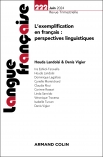
Langue française n° 161 (1/2009)
Pour acheter ce numéro, contactez-nous
Recevez les numéros de l'année en cours et accédez à l'intégralité des articles en ligne.
L’étude de plusieurs corpus d’origines diverses montre que l’adverbe apparemment est susceptible d’occuper des positions très variées dans une phrase donnée. Deux cas semblent particulièrement fréquents, à savoir la position frontale : (1)… Apparemment , nous sommes au début d’un processus, est-ce que ce processus ne risque pas de durer… (Conférence de presse, 01/09/2005). et l’antéposition à un adjectif : (2)…Elle ne rencontra personne en sortant par la cour, se hâtant le long du fournil apparemment désert… (Y. Quéffelec, Les Noces barbares , p. 17, 1985).
The aim of this article is to give a semantic and enunciative description of Modern French adverb apparemment . This description is supported additionally by the evolution of apparemment from Medieval French until today. Modern French presents three separate uses of the adverb. A pparemment , quite scarce today, is a item subjunct which occurs only in negative contexts. Apparemment , is a polyphonic subjunct, and determines an adjective or a past participle with the meaning “seemingly, [but not actually]”. Apparemment is an enunciative polyphonic adverb, very common today in spoken French. When uttering apparemment 3 p , the speaker refers to a certain number of facts, which he presents as indications supporting a conclusion he does not entirely assume. Apparemment is used by the speaker to distance himself from a certain viewpoint. It can be related to a pragmatic function of attenuation, and thus works as a marker of the enunciative attitude of the speaker.

